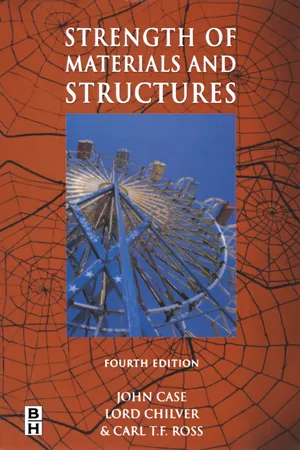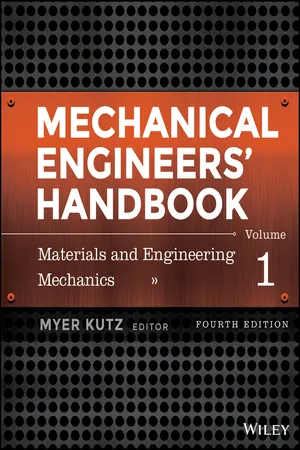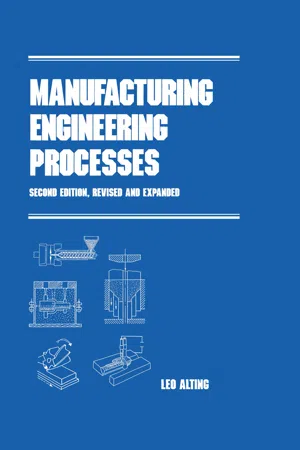Technology & Engineering
Normal Stress
Normal stress refers to the force applied perpendicular to the surface of an object, causing it to deform. In engineering, it is a crucial factor in determining the structural integrity of materials and components. Understanding normal stress helps engineers design and analyze structures to ensure they can withstand the forces they will encounter in real-world applications.
Written by Perlego with AI-assistance
Related key terms
Related key terms
1 of 4
Related key terms
1 of 3
3 Key excerpts on "Normal Stress"
- eBook - ePub
- Carl T. F. Ross, The late John Case, A. Chilver(Authors)
- 1999(Publication Date)
- Butterworth-Heinemann(Publisher)
A ) as δA becomes infinitesimally small. ThusFigure 1.4 Normal load on an element of area of the cross-section.(1.2)This defmition of stress is used in studying problems of non-uniform stress distribution in materials.When the forces P in Figure 1.3 are reversed in direction at each end of the bar they tend to compress the bar; the loads then give rise to compressive stresses. Tensile and compressive stresses are together referred to as direct (or normal) stresses , because they act perpendicularly to the surface.Problem 1.1: A steel bar of rectangular cross-section, 3 cm by 2 cm, carries an axial load of 30 kN. Estimate the average tensile stress over a normal cross-section of the bar.Solution: The area of a normal cross-section of the bar isThe average tensile stress over this cross-section is thenProblem 1.2: A steel bolt, 2.50 cm in diameter, carries a tensile load of 40 kN. Estimate the average tensile stress at the section a and at the screwed section b , where the diameter at the root of the thread is 2.10 cm.Solution: The cross-sectional area of the bolt at the section a isThe average tensile stress at A is thenThe cross-sectional area at the root of the thread, section b , isThe average tensile stress over this section is1.4 Tensile and compressive strains
In the steel wire experiment of Figure 1.1 we discussed the extension of the whole wire. If we measure the extension of, say, the lowest quarter-length of the wire we find that for a given load it is equal to a quarter of the extension of the whole wire. In general we find that, at a given load, the ratio of the extension of any length to that length is constant for all parts of the wire; this ratio is known as the tensile strain. - eBook - ePub
Mechanical Engineers' Handbook, Volume 1
Materials and Engineering Mechanics
- Myer Kutz, Myer Kutz(Authors)
- 2015(Publication Date)
- Wiley(Publisher)
.- SHEAR STRESS is the internal total stress exerted by the material fibers along the plane mn (Fig. 3 ) to resist the action of the external forces, tending to slide the adjacent parts in opposite directions. For equilibrium conditions to exist, the shear stress at any cross section will be equal and opposite in direction to the external force . If the internal total stress is uniformly distributed over the area, the unit shear stress .
- NORMAL STRESS is the component of the resultant stress that acts normal to the area considered (Fig. 4 ).
- AXIAL STRESS is a special case of Normal Stress and may be either tensile or compressive. It is the stress existing in a straight homogeneous bar when the resultant of the applied loads coincides with the axis of the bar.
- SIMPLE STRESS exists when tension, compression, or shear is considered to operate singly on a body.
- TOTAL STRAIN on a loaded body is the total elongation produced by the influence of an external load. Thus, in Fig. 4 , the total strain is equal to . It is expressed in units of length, that is, inches, feet, etc.
- UNIT STRAIN, or deformation per unit length, is the total amount of deformation divided by the original length of the body before the load causing the strain was applied. Thus, if the total elongation is in an original gauge length , the unit strain . Unit strains are expressed in inches per inch and feet per foot.
- TENSILE STRAIN is the strain produced in a specimen by tensile stresses, which in turn are caused by external forces.
- COMPRESSIVE STRAIN is the strain produced in a bar by compressive stresses, which in turn are caused by external forces.
- SHEAR STRAIN is a strain produced in a bar by the external shearing forces.
- POISSON'S RATIO is the ratio of lateral unit strain to longitudinal unit strain under the conditions of uniform and uniaxial longitudinal stress within the proportional limit. It serves as a measure of lateral stiffness. Average values of Poisson's ratio for the usual materials of construction are:
Material Steel Wrought iron Cast iron Brass Concrete Poisson's ratio 0.300 0.280 0.270 0.340 0.100 - Alting(Author)
- 2020(Publication Date)
- CRC Press(Publisher)
Chapter 3 . However, this assumption will not lead to any serious discrepancies at this level.A short introduction to two- and three-dimensional systems of stress is fol- lowed by discussions of the stress-strain curve, true stress, logarithmic or nat- ural strain, volume constancy, and instability. Finally, the yield criteria, which determine the stresses necessary to initiate and maintain plastic flow and the work necessary to carry out the deformation, are analyzed.4.2 TWO- AND THREE-DIMENSIONAL SYSTEMS OF STRESS
The forces that act on a solid body may be classified as either volume or mass forces or surface forces. Volume or mass forces , which include acceleration forces, are not considered in this discussion because they are usually negligible in metalworking processes. Surface forces include forces acting on the surface of every volume element, transmitted either by the interaction of the surrounding material or by external forces.When analyzing design situations for dimensioning purposes or forming pro- cesses for planning or design purposes, it is more appropriate to use the force per unit area as a measure of the load rather than the total force distributed over the area.The force per unit area (described in Chapter 2 ) is called the stress and is usually designated by the symbol σ (sigma):σ =force area( 4.1 )Considering the tensile specimen shown in Fig. 4.1 , the stress on a cross section (1) perpendicular to the longitudinal axis is defined byFIGURE 4.1 A tensile specimen with the cross-sectional area A subjected to the load P .σ =P A( 4.2 )where P is the force and A is the cross-sectional area.If a cross section (2) that is inclined at an angle θ to the longitudinal axis is considered, the mean oblique stress σm is found to beσ m=P=A θP Asin θ( 4.3 )where A θ is the cross-sectional area of cross section 2. This stress [<σ, Eq. (4.2 )] lies in the direction of the longitudinal axis of the specimen. The force P can be resolved or decomposed into two components P n perpendicular to cross section (2) and P t
Index pages curate the most relevant extracts from our library of academic textbooks. They’ve been created using an in-house natural language model (NLM), each adding context and meaning to key research topics.
Explore more topic indexes
Explore more topic indexes
1 of 6
Explore more topic indexes
1 of 4


